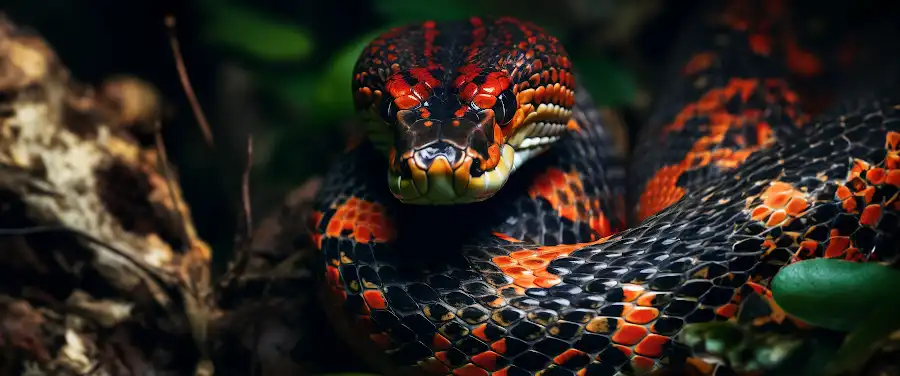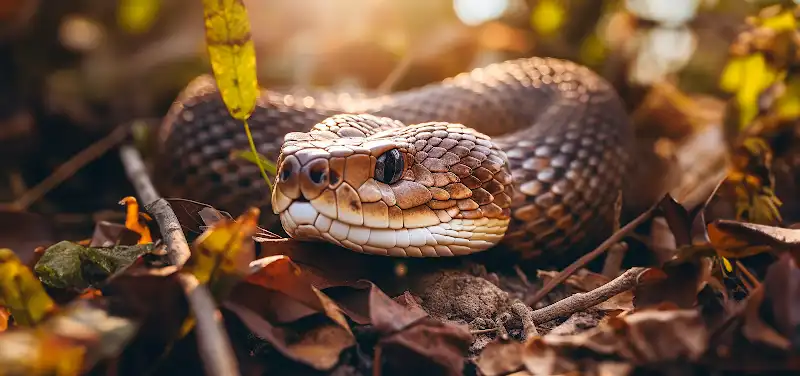
Imagine stepping foot in the heart of the wilderness, where wild beasts lurk around corners and nature rules supreme. The chirping of birds is your background music. As you crunch dried leaves beneath your heavy footsteps and breathe in the fresh forest air, you feel the thrill of blending into the wild. Suddenly, you glimpse a lethally beautiful creature slithering past your feet. Striking colors and piercing eyes captivate you, but then a chill runs down your spine. You’re staring at a venomous snake. Now, isn’t it high time we wrapped our heads around these mind-blowingly dangerous, yet stunning creatures of the wild?
Fatal fascination; that’s what you can call our relationship with venomous snakes. These slinky serpents have long been the stuff of nightmares and fascination, but at the same time, they pose very real threats. The danger doesn’t stop at their fangs, though. The real peril lies in their venom. This potent cocktail of proteins, enzymes, and other compounds is what makes these snakes a deadly outdoor hazard. Understanding snake venom, and how it affects us, can be a matter of life and death.
Packed with a powerful punch, serpent venom can cause paralysis, tissue destruction, blood clot disruption, and in grave cases, it can lead to fatality. That’s why, it’s crucial for every outdoor enthusiast, wildlife explorer, or anyone who steps out into nature to understand the strength and dangers of deadly snakes. We’ve heard the stories, watched the movies, and perhaps even gawked at these scaly creatures behind glass. But, before you tread further into their realm, it’s time to truly grasp the danger lurking in their fangs. As we journey into the world of these venomous creatures, we’re going to reveal the facts that you need to know about these perilous predators of the wild. After all, knowledge is power, especially when you’re dealing with the world’s deadliest outdoor hazard – the venomous snakes.
Stay with us as we delve deeper to explore what differentiates a harmless garden snake from a venomous threat, and most importantly, “What makes a Snake Venomous?” After reading this, you’ll have a new-found respect for these creatures, and of course, a survival cheat sheet for your next adventure.
Which are the Most Common Venomous Snakes?

You’ve probably heard chilling tales about snake encounters during outdoor adventures, and for a good reason. Snakes, specifically venomous sorts, pose a significant outdoor hazard globally. Whether you are a seasoned hiker, a bird watcher, or just like to enjoy the serenity of nature, it does no harm to inform yourself about some of the most common venomous snakes that might cross your path.
Among these feared reptiles are the likes of rattlesnakes, cobras, and vipers, each carrying a potentially lethal bite. Let’s delve deep into this fascinating, albeit fearsome, world of venomous serpents.
Rattlesnakes
Rattlesnakes, a group of pit vipers, are one of the most familiar venomous snakes found extensively in the Americas, from Canada to central Argentina. These snakes are easily identifiable by the eponymous rattles on their tails. Beautiful, but dangerous, they’re known for packing a venomous punch that can be potentially life-threatening to humans.
Cobras
Cobras might bring to mind hypnotic snake charmers of the East, but don’t be fooled; these snakes can deliver a venom potent enough to cause breathing difficulties, paralysis, and even death. These deadly reptiles are indigenous to Asia and Africa. They are ordinarily recognized by the unique ‘hood’ they display when threatened.
Vipers
Vipers represent a large family of venomous snakes comprising well-known species like the deadly Saw Scaled Viper and Russell’s Viper. Distributed widely across the world, from deserts to mountains and everything in between, these snakes are known for their long, hinged fangs capable of deep venom injection.
| Snake Family | Key Characteristics | Typical Habitat | Potential Danger |
|---|---|---|---|
| Rattlesnakes | Rattles on the tail | Americas | Potentially life-threatening |
| Cobras | Unique ‘hood’ | Asia and Africa | Paralysis, Death |
| Vipers | Long, hinged fangs | Global | Deep venom injection |
It’s worth noting that the actual danger posed by these snakes largely depends on multiple factors, including the species, the nature of the encounter, and the individual snake’s disposition. But regardless, an encounter with a venomous snake should always be treated with caution.
According to the World Health Organization, snakebite envenoming affects 1.8–2.7 million people each year, underscoring the dangers of venomous snakes. Therefore, it’s imperative to be well informed and prepared about these feared reptiles if your passion or work leads you outdoors frequently.
In the upcoming section, we will explore just how dangerous are venomous snakes? Stay tuned to comprehend the perils associated with them, and importantly, learn how to navigate these hazards effectively.
How Dangerous are Venomous Snakes?

Let’s delve into the profiles of the most deadly species! When it comes to outdoor hazards, venomous snakes represent one of the most potent threats globally. These dangerous creatures, while fascinating in their unique physiology and behavior, should not be taken lightly due to their potential risk to human life.
Statistical Glance at Snake Bite Incidents
Appreciating the dangers starts by understanding the facts. Every year, over 100,000 people worldwide succumb to snake bites. Moreover, the World Health Organization (WHO) estimates that roughly five million people are bitten annually, with envenomings or poisonings happening between 1.8 and 2.7 million times!
| World’s Deadliest Snakes | Known Habitat | Average Annual Deaths |
|---|---|---|
| Saw Scaled Viper | Asia, Middle East, Africa | 5,000 |
| King Cobra | India and Southeast Asia | 1,000 |
| Eastern Brown Snake | Australia, Papua New Guinea | 5 |
| Death Adder | Australia, New Guinea | 100 |
In spite of the numerous non-venomous snakes around, there exist certain species like the Saw Scaled Viper, King Cobra, Eastern Brown Snake, and the Death Adder that account for a large number of annual snake bite deaths.
Venom Constituents and Their Impact on the Human Body
The real danger lies within the venom, a toxic cocktail produced by specialized glands. This usually contains a mix of proteins and peptides which can affect the body in unique ways. Depending on the snake species, venom could be neurotoxic (impacting the nervous system), hemotoxic (affecting the blood), or cytotoxic (damaging the cells and tissue).
For instance, the venom of a King Cobra, one of the most dangerous snakes, can lead to paralysis and death due to respiratory failure. On the other hand, a bite from a Saw Scaled Viper can cause considerable internal bleeding, followed by multiple organ failure.
Now that we’ve shed some light on the dangers of venomous snakes, it’s essential to remain cautious, particularly when venturing into their known habitats. For more information, check out this source, which provides a wealth of knowledge on this subject.
Transitioning from understanding the risk, let’s discuss the immediate effects one may experience after an unfortunate encounter with these venomous critters. ” What are the Immediate Effects of a Venomous Snake Bite?”
What are the Immediate Effects of a Venomous Snake Bite?

A venomous snake bite can quickly turn an adventurous outdoor escapade into a life-threatening situation. As many as 1.2 million people every year fall victim to snake bites, according to the World Health Organization. These bites can result in a plethora of symptoms varying in severity, starting from the acute stage to more long-term implications.
When discussing snake bite symptoms, the most immediate and evident consequence of a venomous bite is often a sharp, searing pain at the site of the bite. This discomfort intensifies as the venom starts disrupting the bodily functions. Some people may also experience swelling, redness, and bruising around the bite area, with the skin taking on an eerie, mottled appearance.
The severity of a venomous bite can drastically differ based on the species of the snake and the volume of venom injected. Ranging from mild to life-threatening, these bites can cause symptoms like nausea, sweating, rapid heartbeat, difficulty in swallowing or breathing, and blurred vision. In severe cases, paralysis or death can occur shortly after.
Focusing on the long-term snake bite effects, venomous bites often come with complications if not managed appropriately right from the onset. While a majority of venomous bites rarely leave lasting afflictions, some can develop long-term physical and mental health problems, including post-traumatic stress disorder, local tissue damage, amputations, or even kidney failure, also known as snakebite nephropathy.
| Common Dangerous Snakes | Symptoms of Bite | Chances of Bites Resulting in fatalities (%) |
|---|---|---|
| Eastern Brown Snake | Extreme pain, paralyzation, collapse | Approximately 50% |
| Black Mamba | Fast heartbeat, difficulty in swallowing, paralysis | Estimated at 100% without timely treatment |
| King Cobra | Severe pain, vision loss, possible death | Around 75% without medical intervention |
| Death Adder | Rapid onset paralysis, respiratory failure | Ensures roughly 50% fatalities without antivenom |
| Inland Taipan | Abdominal pain, headache, dizziness, death | Known to have 100% fatality rate without treatment |
As we move to our next topic, ‘How to Avoid Snake Bites When Outdoors?’, it becomes apparent that understanding the immediate dangers of venomous snakes only forms half of the equation. The other half lies in understanding how to prevent these hazardous encounters. Keep reading to explore all that and more!
How to Avoid Snake Bites When Outdoors?

When people think about the hazards of the great outdoors, it’s often giant predators like bears or sharks that first come to mind. But interestingly, the number one killer isn’t the massive beasts. It’s something much smaller but much deadlier: venomous snakes. There are currently an estimated 3,000 species of snakes worldwide with about 600 of those venomous and potentially fatal to humans.
The key to avoiding snake bites outdoors is preparation, awareness, adoption of safe practices, and wearing the right protective outdoor attire.
Proper Outdoor Attire to Protect Against Snake Bites
A key part of snake bite prevention is dressing appropriately. Clothing can act as the first line of defence against snake bites. Stick to long pants and tall boots when in snake-prone areas. Heavy denim and leather can prevent most snake fangs from penetrating through to skin. Gaiters are another effective protective gear, worn over the shoe and lower leg, that provides extra coverage against unexpected snake encounters.
Importance of Awareness and Caution
Constant vigilance! This quote from Harry Potter serves as an apt reminder. Always be cautious and aware of your surroundings. Watch where you step, avoid tall grass and piles of leaves where snakes may be hiding. Don’t reach into cracks or crevices in rocks, under logs or into thick patches of wildflowers without checking them out carefully first.
Keep your hearing sharp and listen out for any warning signs. Some venomous snake species like rattlesnakes have distinct sounds to alert potential threats. Additionally, be aware of the time – snakes are more active during dusk and dawn.
A dash of common sense can go a long way in avoiding snake bites outdoors. Never provoke or attempt to handle a snake, regardless of whether it’s venomous or not. More often than not, snakes only attack when they feel threatened. Your safest bet is to give any snake you encounter a wide berth. According to the CDC, about half of all venomous snake bites are “dry” and contain no venom. However, they can still be quite painful and lead to serious infection.
We are the guests in nature’s domain, and it’s imperative that we respect all its inhabitants, regardless of whether they crawl, walk, or fly. The virtues of caution, respect, and awareness go a long way in ensuring we return home safe, sound, and bite-free.
We hope these safe practices provide good guidance in maintaining safety while navigating snake-infested regions. But life is unpredictable. Now, let’s focus on the potential scenario where, despite best efforts, one gets bitten by a venomous snake.
Conclusion
The world we dwell in is strikingly beautiful and equally perilous. We’ve traversed the world of venomous serpents, revealing the hidden dangers of venomous snakes. An encounter with one, whether in the wild or even in more inhabited regions, can potentially lead to life-threatening results. Thus, understanding their menace can be the difference between life and death.
Stepping out into the great outdoors can feel liberating, but the possibility of crossing paths with lethal creatures demands caution. Snake bites are a health hazard globally, and most occur due to accidental contact, often due to a lack of knowledge about these intriguing creatures. So, one thing is sure – the importance of education when dealing with the dangers of venomous snakes can’t be overstressed.
Prevention always outweighs a cure, particularly in the context of venomous snakes. By knowing how to identify the species, their preferred environments, their behavior, and equipping ourselves with the necessary tools and strategies, we become better prepared to deal with such encounters.
Yet, one might question – why worry about a danger so deeply cloaked within the folds of nature? The answer is simple. Each year, snakebite incidents claim numerous lives and cause untold suffering globally due to less accessible medical assistance and a lack of awareness.
It all circles back to one idea – prevention. And prevention begins with education. Understanding the dangers of venomous snakes enables us to respect the boundaries between humans and wildlife, promote ethical interaction with these creatures, and, most importantly, protect our lives.
To paraphrase an old adage – forearmed is forewarned. Here, being armed with knowledge about venomous snakes and their dangers will empower you to be vigilant and smart, minimizing risks of unfortunate encounters with these creatures. Every outdoor enthusiast, biologist, traveler, or rural inhabitant can vouch for it.
So, what is the takeaway from this journey into the world of serpent venom? It unfolds as a stark reminder of the importance of harmonizing our curiosity with caution. It’s a call to acknowledge an unspoken border we share with all creatures, venomous or not. It reiterates the relevance of informed choices when venturing into shared habitats.
In this perilous yet mesmerizing expanse of nature, the more we know about our non-human neighbors, the better equipped we are to elevate our outdoor experiences from being merely adventurous to responsibly thrilling, and that is the true essence of exploring our world.




